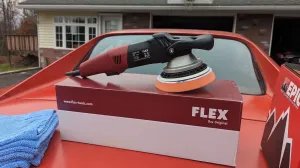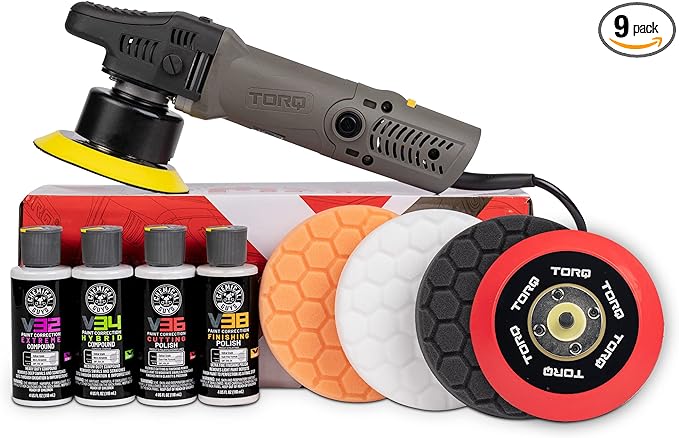We may earn revenue from the products available on this page and participate in affiliate programs. Learn more ›

You take pride in washing and polishing your car’s paint, but no matter how much you buff and wax, you can’t seem to get rid of those pesky swirls and hard watermarks. By the time you’re done working, your arm is tired, your shoulder is sore, and your back aches. There’s an easier and better way to polish your car, and it involves the use of tools.
The best orbital polishers can help you achieve a beautiful finish that’s free of marks and blemishes. These aren’t your traditional polishers that just spin in place—the orbital movement makes for an easier user experience and reduces the risk of damage to your paint. This guide will explain the best orbital polisher options on the market and how to choose the best one for your needs.
From basic to advanced, budget-friendly to top dollar, there’s an orbital polisher that can do just about any job you need to restore your vehicle’s paint to a pristine shine that’s free of annoying swirl marks, scuffs, and water stains. Not only will an orbital polisher save you time over hand waxing, it will give your back, shoulders, and arms much needed relief. I’ve got you covered with my top picks and a handy buying guide to answer your most burning questions.
Summary List
- Best Overall: Flex XC 3401 VRG Dual Action Gear Driven Orbital Polisher
- Best Value: Black and Decker Random Orbit Waxer/Polisher
- Honorable Mention: Chemical Guys Random Polisher Kit
- Best Premium: DeWalt Polisher
- Best Busget Starter Kit: SPTA Buffer Polisher
Our Methodology
When it comes to choosing the best orbital polishers, I wanted to provide you with a well-rounded list that features a good variety of reputable manufacturers with solid track records of providing high-quality, reliable products. I included a wide range of prices to suit any budget. I focused on orbital polishers that use the latest technology and that feature innovative designs suitable for a wide variety of users. For more information on the selection criteria, check out The Drive’s Gear About page, which explains our methodology further.
Best Orbital Polishers: Reviews & Recommendations
Best Overall: Flex XC 3401 VRG Dual Action Gear Driven Orbital Polisher
I’ve been using the Flex XC 3401 gear-driven polisher for over a year now. It’s a pro-grade piece of equipment for anyone who’s serious about detailing needs in their collection. It’s been used on a variety of vehicles with both modern clear coat paints and classic single-stage setups. The level of quality is matched by both it’s performance and ease of use. It’s also rocking some seriously beefy internals to guarantee a long service life.
The only real drawback of this unit is how expensive it is. That alone is going to lead many non-professionals to skip right over it. Though, if you are a professional, it’s clearly the way to go.
Best Value: Black and Decker Random Orbit Waxer/Polisher
This six-inch orbital polisher operates at 4,400 orbits per minute. The 10-foot cord makes it easier to work with and maneuver. The two-handle design makes it easier to control; the handles are cushioned and comfortable to hold for the entire polishing job. The polisher only weighs 5.3 pounds, making it lightweight to reduce arm fatigue. Included with your polisher are one foam applicator pad and two polishing bonnets. You can use this polisher to apply wax, buff, and polish your vehicle’s paint.
Unfortunately, the included foam bonnet isn’t the most durable, which can result in it tearing during use. Most car enthusiasts buy pads anyway. This polisher doesn’t have a variable-speed option either, which can make the application of compounds limiting.
Honorable Mention: Chemical Guys Random Polisher Kit
Make your car’s paint shine with this complete care and polishing kit. It comes with a heavy-duty and powerful polisher along with a strong motor that’s 120 volts and 700 watts that can run at 2,800 to 7,800 rpm. Beginners will find this polisher easy to use with its streamlined controls. You can use this polisher to remove the defects, swirls, and scratches from your car’s paint.
One drawback of this polisher is that it can have a strong vibration at lower speeds. You may also find that the power switches are in awkward places or hard to reach. The pad on this polisher is also smaller than other polishers on this list. However, this is also an advantage for precise work and defect removal.
Best Premium
DeWalt Polisher
Our Verdict on the Best Orbital Polishers
For the ideal combination of durability, reliability, functionality, and price, the Flex XC 3401 VRG Dual Action Gear Driven Orbital Polisher is my top overall choice for an orbital polisher. For a budget-friendly choice, consider the Black and Decker Random Orbit Waxer/Polisher. It’s a lightweight and comfortable option that’s great for beginners.
What to Consider When Buying Orbital Polishers
There’s not a one-size-fits-all strategy for purchasing the ideal orbital polisher. Taking certain factors into consideration will help you quickly and confidently weed through the various options and get the one that best suits your needs.
Types
Standard
This is the most common type of orbital polisher that’s on the market. Standard polishers are most often found at hardware and auto parts stores. However, you won’t find many professional quality polishers in this type since they lack the polishing ability and strength for commercial use. This style of orbiter moves in a similar motion to how your hand would move while polishing your car. The pad doesn’t spin; instead, it moves in a circular motion as if it’s drawing a circle.
Random
These polishers are a bit of a combo in how they move since they are between a standard and rotary polisher. The pad does a solid spin like a rotary polisher, then it moves in a circle like a standard polisher and does both of these movements simultaneously. The actual movement is random and generated by the momentum of the spin. It can change based on stroke strength, grip, and pad size.
Forced Rotation Dual Action
These polishers combine orbital and rotary motions into a simultaneous, forced action. Unlike a random orbital polisher that relies on momentum from the user to rotate the pad, these polishers drive the orbiting and rotating motions together in a consistent pattern. They’re stronger than random orbital polishers but still easy to use and safe for beginners.
Rotary
This type of polisher is the most difficult to master and gain. The pad spins in a continuous circular motion that is smooth and consistent motion, creating the most amount of friction and heat. You’ll want to be careful about how you use these polishers because the heat buildup can damage your paint. It can also create holograms in the finish. However, this type is the most effective at fixing blemishes and scratches in the paint.
Orbital Polisher Key Features
Speed
The most important factor to consider is the polisher’s speed. The faster the speed, the better it can create a deep polish and remove scratches. You’ll need to be careful, though, since the higher speeds produce more friction, and potentially damaging heat. The ideal buffer speed is between 2,000 and 4,000 rpm.
Size
Find a polisher that is small enough to make it easy to move around your vehicle. It also needs to have a large enough plate to give you plenty of polishing surface. The larger the polishing pads, the more coverage you get, and the faster you can polish your vehicle. Too large of a polishing pad may make it difficult to polish smaller areas, though.
Weight
Since you have to hold your polisher the entire time you’re using it, a polisher that seems lightweight in the beginning can become very heavy by the end. Don’t choose a polisher that will fatigue your arms and cause you to quit before you’ve completed your vehicle. Lightweight polishers are comfortable and allow you to polish more in one session.
Pricing
You can get a lightweight, basic orbital polisher, which is an ideal choice for beginners, for less than $50. They offer an easy-to-use, straightforward setup and not a ton of bells and whistles. For a well-constructed, powerful and more professional-level orbital polisher, expect to spend between $65 and $150. These will come with good warranties, multiple application pads, and may even have interchangeable handles. If you’re a serious polisher and want a professional-grade, heavy-duty product, expect to spend more than $200.
FAQs
You’ve got questions. The Drive has answers.
A: Yes, you can. Make sure that it’s orbital and has a variable speed and be sure to replace the sandpaper with a buffing pad. Apply a product, turn on your sander, and accelerate as you work.
A: Orbital polishers are unlikely to damage your car’s paint job. Unlike standard polishers, they spin at a safer, lower speed that isn’t likely to burn paint off. Many of these polishers also have spindles built in that will stop rotation if too much pressure is applied.
A: Yes, you can. Attaching a medium-grade cutting pad to your polisher and using it to apply a polishing compound can help correct surface scuffs, swirls, and minor scratches. If you’re new to this procedure, be sure to practice on an inconspicuous place or another surface prior to really getting after it.








